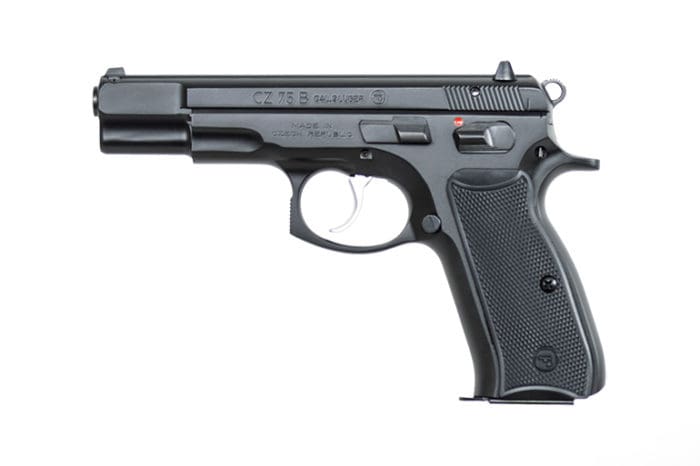If you have to or would like to install a new set of CZ 75 sights, here are a few tips I’ve collected after having attempted to do so recently.
This, dear readers, is a story of a failure. Instead of showing you victory, I’m going to show you where I went wrong and therefore what you should do (or at least what I think you should do) to avoid making the same mistakes I did. Most of them were due to hubris and the pitfalls of being a cheapskate. After all, this is “The Truth About Guns” not “Make Me Look Good About Guns.”
Some people learn the hard way.
I learned these lessons trying to install a TruGlo TFO set on my TriStar/Canik C100 pistol (a CZ 75 Compact clone) which has dinky sights and the same sight cuts as a full size CZ 75. The set includes a black steel rear ramp sight and a fiber optic front sight.
If I had a really, really big complaint about the gun industry, it’s that they don’t install fiber optic sights as standard and they are way better than three dots…but I digress.
In the broad strokes, the CZ 75 family (including the many clones) actually have one of the most logical sight cuts. The front sight is dovetailed longitudinally and secured with a roll pin, which ensures you don’t have to adjust for windage.
On many models, the rear sight dovetail has a lip on the right side. This means the sights must be drifted out from right-to-left and drifted in from left-to-right. Since the lip on the dovetail also ensures the sight can’t be drifted too far to the right, this also means you probably won’t have to adjust for windage there either. This isn’t true for all models, however.
Like I said, it’s pretty darn logical.
However, just as with any other handgun sight cut and sight design, there are some intricacies, subtleties and so-on that you should be aware of before taking the plunge.
First, let’s talk about the front sight dovetail.
As mentioned, the front sight dovetail of CZ 75 pistols and many clones is longitudinal, meaning it runs front-to-back instead of side-to-side, with the front sight getting sandwiched between the slide and the barrel bushing.
Some sights come pre-milled with a roll pin slot and others do not. In the former case, you have to install the sight and then tap a hole through the base of the sight so the roll pin can be punched back in.
Personally, I think it’s wisest to err on the side of caution and not have to drill out the roll pin slot. This much is up to you. After all, it’s only going to take you a few seconds with a drill bit. If you go this route, it’s strongly recommended that you use a drill press rather than a hand drill, but plenty of people have no issues with the latter.
As for installing handgun sights, some aftermarket sights will be too large to fit in the dovetail and will need to be polished to fit.
The general guideline is to polish the dovetail until it can fit at least one-third of the way into the slide dovetail with minimal pressure. What I’m going to recommend here is that you go a little beyond that if you’re installing a new sight for a CZ 75 pistol or any clone or iteration thereof with a similar sight dovetail. The front sight dovetail is the same design, but different dimensions, on the CZ P10 series, as well as the 75D PCR, SP-01 and others.
ESPECIALLY — AND I’M USING ALL CAPS FOR A REASON — IF YOU’RE INSTALLING A FIBER OPTIC FRONT SIGHT.
As I said, this is a record of a failure. I got to about one-third of the way into the dovetail and then tapped the sight the rest of the way in, whereupon this happened:
The thing about those fiber optic sights, folks, is there’s not a lot of metal to them, so they can’t take much pounding. Hence, polish a little more material away to minimize the drifting needed to fully seat the sight in the dovetail. Not too much, but what seems necessary…plus a little bit more.
I’ve ordered a new front sight, so this problem will be remedied ASAP. TruGlo’s warranty is void if you install them yourself, so I’m hosed on that front.
Like I said. I figured I’d be able to do it myself without buying a small rubber mallet and just being gentle. Hubris and cheapskatery bit me in the keister, so let that be a lesson to me and hopefully to you, too, if you haven’t ever changed your own sights.
As for the rear sight, it turns out you really DO need a sight pusher. When I tried it with a standard claw hammer and a punch (with the slide in a vise), the rear sight didn’t move AT ALL.
Granted, just looking at the new sight picture with the fiber optic rod and the factory rear sights…I’m questioning whether I even want to install the rear sight at all. Just adding the FO front sight accomplishes most of what I wanted out of buying this set to begin with. I have a better sight picture for (hopefully) more accurate shooting.
However, I also know that I’ll need a pusher for changing the sights on any pistols I acquire in the future. Buy once, cry once.
Who cares about this crap? Well, a good number of people try to do things the DIY way with minimal tools. They figure, “Hell, it’s just a few taps with a hammer; I don’t need to buy X, Y, or Z.” It turns out, you really do.
Discuss amongst yourselves in the comments. Ridicule away if you feel you must.
